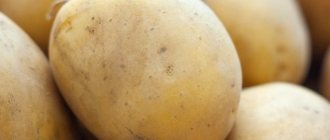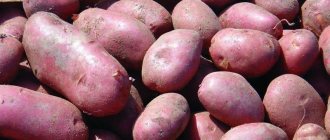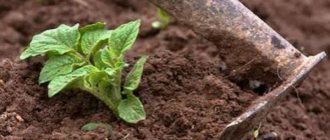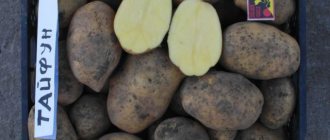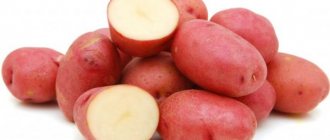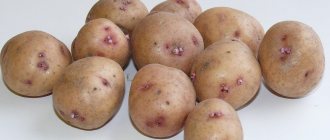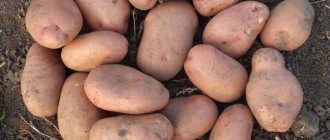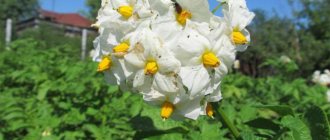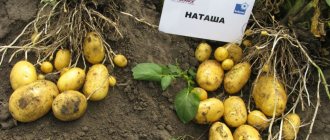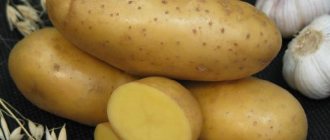Description of the variety
| Variety name | Cast iron |
| general characteristics | early maturing table variety of folk selection, resistant to drought, yield is not high |
| Maturation period | 70-75 days |
| Starch content | 10-17% |
| Weight of marketable tubers | 100-130 gr |
| Number of tubers in a bush | 6-11 |
| Productivity | 100-200 c/ha |
| Consumer qualities | excellent taste, suitable for preparing any dish, contains a lot of protein and vitamins |
| Keeping quality | 95% |
| Peel color | blue-violet |
| Flesh color | cream or white |
| Preferred Growing Regions | any soil and climate |
| Disease resistance | resistant to leaf curl virus, mosaics, black leg, susceptible to late blight |
| Features of cultivation | standard agricultural technology, prefers light soils, it is recommended to dig up tubers after full ripening |
| Originator | Not included in the register of varieties of the Russian Federation and other countries. |
Advantages and disadvantages
Cast iron can boast a rich history of cultivation in various regions of Russia. Therefore, despite the lack of recognition of Chugunka at the academic level, much is known about the characteristics of the variety thanks to the wide experience of gardeners.
pros
Cast iron is popular with many owners of small private farms - and they remain faithful to this variety for many years. Gardeners note the following positive characteristics of Chugunka potatoes:
- drought resistance – the variety’s crop will not die in dry summers;
- high taste qualities – Chugunka potatoes have an excellent, pronounced taste, and their delicate, crumbly structure is ideal for puree;
- high nutritional characteristics - Cast iron contains a lot of starch (17%), vitamins, antioxidants, amino acids and other useful substances;
- resistance to diseases such as blackleg, leaf curl, mosaics;
- high marketability: Chugunka tubers are mostly large, beautiful, with small eyes;
- safety - potatoes, based on the characteristics of Chugunka, can be stored without spoilage for 7-8 months.
As you can see, the Chugunki variety has many advantages - it’s not for nothing that it is called the classic peasant potato.
Minuses
The variety does not have many negative characteristics. Here are the main disadvantages that can be found in Cast iron:
- low yield: from the middle plot of Chugunka you can harvest much less potatoes than the characteristics of expensive varieties promise;
- sensitivity to mechanical damage from agricultural machinery – Cast iron is best processed and assembled by hand;
- loss of marketability during transportation - the characteristics of this potato indicate a very thin peel, cast iron is easily damaged when shaking in a car;
- need for fertilizers – the Chugunka variety requires a large amount of organic and mineral fertilizing in order to become as healthy and palatable as its characteristics promise;
In general, it can be seen that Chugunka is a good variety for small gardens, but its characteristics are not very suitable for cultivation in large volumes for sale.
Characteristics of potatoes
Potatoes “Chugunka”, variety description: refers to early ripening table potatoes. Some reference books consider the variety to be a table-fodder variety. The growing season is 70-75 days. It is recommended to dig up the tubers at the end of ripening; they acquire a rich taste and become more useful .
Productivity depends on the climatic zone and nutritional value of the soil, ranging from 100 to 200 centners per hectare. Collected tubers are well stored and suitable for transportation and sale.
Read about how to properly store potatoes in winter, what the deadlines are, and the intricacies of storing potatoes in boxes in the special materials on our website. We will also tell you all about storing peeled potatoes and is it possible to store raw, boiled and fried potatoes in the refrigerator?
Potatoes are rarely affected by cancer, rot, or viruses . It practically does not suffer from blackleg and is resistant to leaf curl or mosaics. Infection with late blight is possible; during an epidemic, plants need especially careful care.
Bushes of medium size or tall, intermediate type, erect, with not too spreading branches. The formation of green mass is abundant, the leaves are medium-sized, dark green, with slightly wavy edges and clearly defined veins.
The corolla is compact, collected from large pink-violet flowers. Berry production is low. The root system is powerful; at least 10 large potatoes are tied under each bush. With proper care, ugly tubers are rarely formed, and there are few non-marketable items.
Planting care is standard . Tubers are planted in well-warmed soil; it is necessary to monitor the level of humidity. The variety prefers light soils, but also grows on loam without problems.
To increase nutritional value, humus or wood ash is added to the soil. Hilling with the formation of high ridges and timely weeding are required. A one-time feeding with a mineral complex or organic matter is possible.
Tubers of the Chugunka variety have a pleasant, rich taste. They make an airy puree of a beautiful white color. Tubers can be fried, stewed, baked or stuffed; they do not darken when cut .
One of the most important indicators that matter when choosing a variety for cultivation is its yield. In the table below you will find this characteristic for different varieties presented on our website:
| Variety name | Productivity |
| Santa | up to 570 c/ha |
| Tuleevsky | 400-500 c/ha |
| Kolobok | 450-600 c/ha |
| Ilyinsky | 180-350 c/ha |
| cornflower | 200-480 c/ha |
| Laura | 330-510 c/ha |
| Irbitsky | up to 500 c/ha |
| Sineglazka | up to 500 c/ha |
| Adretta | up to 450 c/ha |
| Alvara | 295-440 c/ha |
History of breeding of the variety and regions of its cultivation
Cast iron is the fruit of the work of national breeders; there is no information about potatoes in the register of breeding achievements. There is also no exact information about the author, the date of appearance of the variety; according to unverified data, one of the parent varieties is Sineglazka.
The variety has won the love of summer residents and owners of small plots for its unpretentiousness. Potatoes are recommended for regions with temperate climates and for the southern regions.
Did you know? According to a fact from the Guinness Book of Records, the world's largest potato tuber weighed 8 kg.
Origin
The Chugunka variety is one of the brightest examples of folk selection. It is not included in the State Register of the Russian Federation, but is widespread among amateur gardeners and is grown in different regions. Among the ancestors of potatoes is the famous Sineglazka; the tubers are actively used for breeding work.
The variety is suitable for cultivation in private farms, as well as on small farms. Potatoes are not suitable for industrial cultivation. The variety is planted in areas with temperate and warm climates; the bushes tolerate short-term drought without problems.
When using the same seed material for a long time, potatoes degenerate. To increase the mass of tubers and increase productivity, periodic renewal of tubers for planting is recommended.
Diseases and parasites
Cast iron does not suffer much from most standard potato diseases, but is afraid of attacks from the Colorado potato beetle and late blight bacteria.
Potato cancer
The main characteristic by which the disease is determined is greenish growths on any part of the potato. It is transferred with the soil, so you need to monitor the sequence of plantings (do not plant Chugunka after nightshade) and the safety of neighboring areas.
For prevention, the seed material of the variety is disinfected with a solution of “Fundazol” or “Nitrophen”. All affected Chugunka tubers must be burned.
Late blight
Phytophthora, to which the Chugunka variety is susceptible, manifests itself as rounded brown ulcers on the leaves and tubers. It is better to warn her appearance in advance. The main method of successful prevention is careful sorting of Chugunka tubers.
Before sowing, potatoes are treated with Phytozonite, Ribav Extra and other means that increase resistance to fungus. At the first signs of late blight, the entire Chugunka bush is removed from the area and destroyed.
Colorado beetle
This is the most dangerous pest of most potato varieties in Russia. The first beetle treatment is carried out in late May, when the Chugunka bushes begin to bloom. The most popular chemical preparations are: Corado, Confidor, Iskra, Deciz-Profi, which have unique disinfecting characteristics.
It is recommended to repeat the procedure for Cast Iron no less than 2 and no more than 4 times per season. In small plots, gardeners can collect beetles by hand - this is difficult work, which pays off with the environmental cleanliness of the ripened potatoes.
Advantages and disadvantages
Among the main advantages of the variety:
- good taste of root vegetables;
- early amicable maturation;
- low maintenance requirements;
- drought resistance;
- collected tubers are well stored;
- resistance to diseases and pests.
Among the minor shortcomings:
- sensitivity to soil nutrition;
- It is recommended to update the seed material every few years.
In the table below you will find keeping quality indicators for comparing Chugunka potatoes with other varieties:
| Variety name | Keeping quality |
| Breeze | 97% |
| Zekura | 98% |
| Kubanka | 95% |
| Sturdy | 97% |
| Felox | 90% |
| Triumph | 96% |
| Agatha | 93% |
| Natasha | 93% |
| Red Lady | 92% |
| Uladar | 94% |
Diseases and pests: how to fight
Potatoes also have their weaknesses. More often, bushes can be affected by late blight (lack of iron). To restore the iron balance, it is worth treating the above-ground part with copper sulfate.
Ready-made potatoes are the result of a gardener’s painstaking work
Like any other type of potato, Chugunka is loved by Colorado potato beetles. Special preparations are used to combat these pests.
If we consider the description of this potato variety, it will seem that the crop simply has no shortcomings. In fact, there are some nuances regarding care and planting. If you take everything into account, the harvest will be impressive, and its storage until spring will cost no losses.
Features of cultivation
Potatoes are planted closer to mid-May, the soil should warm up well. Before planting, the tubers are pickled, dried, and treated with growth stimulants .
After this, the potatoes are germinated in the light or in wet sawdust. Healthy, undamaged tubers with strong, powerful sprouts are selected for planting. The soil for planting can be any.
The variety easily tolerates heavy soil, but on a light fertile substrate the yield increases significantly. The nutritional value of the soil is increased by humus or wood ash; a single fertilizing with a solution of superphosphate or diluted mullein is possible . Foliar feeding is also useful; it is carried out 10 days before harvesting.
For more information about how and when to apply fertilizers, as well as how to do it correctly when planting, read the articles on our website.
Every 2-3 years, areas for planting potatoes need to be changed. The vacated areas are sown with lupine, oilseed radish or phacelia.
Legumes, cabbage or carrots will be good predecessors for the crop. Planting in areas previously occupied by meadow grass also produces good results.
The bushes are placed at a distance of 30 cm from each other, a distance of 60 cm is left between the rows. The tubers are buried 10-12 cm . Plantings need to be watered only in dry summer conditions. In wet weather, plantings are pollinated with wood ash, this prevents root rot or blackleg.
During the growing process, the plantings are hilled 1-2 times to form high ridges. All weeds are removed at the same time. Mulching the rows with straw or mown grass will help make the process easier.
Spraying with various preparations is very important in growing potatoes. Read all about the use of herbicides, fungicides and insecticides.
We also suggest that you familiarize yourself with other methods of growing potatoes: under straw, in bags, in barrels, using Dutch technologies.
Harvesting and storage
The Chugunki variety is harvested, according to its characteristics, in the twentieth of August. 7-10 days before the start of harvesting, the tops of the potatoes are completely cut off. By this time it should have turned yellow by at least a third.
When harvesting such a fragile variety as Chugunka, it is permissible to use only a shovel.
The harvested crop is stored in wooden oblong boxes with long slits. The cellar for storing Chugunka potatoes should be cool (up to +3°), not cramped and dark. The harvest must be sorted every month and a half.
Review of cast iron potatoes
Currently, it is not easy to decide on the choice of potato variety among a wide range. A large number of interesting varieties are presented on the markets, but many gardeners are still growing proven old varieties. Thus, they protect themselves from exposure to GMO products.
The unusual variety of potatoes “Chugunka” is very popular among summer residents, although it is not found in the official registers of any country. Fans of this product call it real peasant potatoes. The name “Chugunka” comes from the lilac color of the potato peel. A lot of useful information about this original variety can be obtained if you carefully read this article.
Comparison table with other early ripening species
| Variety name | Average tuber weight, g | Starch content, % | Productivity, c/ha |
| Cast iron | 100-130 | 12-17 | 100-200 |
| Alyona | 100-130 | 15-17 | 130-190 |
| Ariel | 80-170 | 13-16 | 220-480 |
| Bellarosa | 120-150 | 12-16 | 290-350 |
| Impala | 100-127 | 10-15 | 400-470 |
| Karatop | 60-100 | 11-15 | 240-400 |
| Natasha | 100-130 | 12-14 | 130-190 |
| Timo | 80-90 | 13-15 | 200-380 |
Farmer reviews
Feedback from farmers about Chugunka is mostly positive. Despite the average yield, farmers continue to grow this variety.
Inna, Ryazan: “A couple of years ago I planted Chugunka for the first time. I found some unusual purple tubers at the market. The harvest is really average, but the fruits are very tasty, tender and crumbly. The variety is susceptible to late blight, so I spray all the nightshades in the area with copper sulfate.”
Victor, Tver: “I’ve been growing cast iron for more than one year. Potatoes are ideal for mashing. The yield is satisfactory and he rarely gets sick. The only problem is pests. I found a way to fight the Colorado potato beetle. We reach an agreement with our neighbors and collect all the beetles and larvae on our property in one day. After that, the insects don’t attack.”
